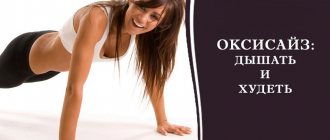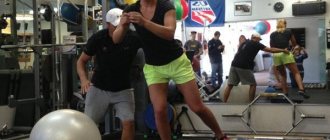If you want to start diving into acrobatics, calculate your strength and start gradually. The best way is to enroll in a group that teaches acrobatics for beginners. If you are afraid of showing clumsiness in class or want to tighten up your body a little while dieting in order to lose weight better, start small - with a warm-up.
Neck warm-up
Perform circular movements with your neck, first in one direction, then in the other direction. Then tilt your head back and forth and left and right.
Warm up the arms and shoulder girdle
- Lower your hands down, clenching them into fists, then begin to swing back with each hand in turn - one hand should be raised, the other should be lowered.
- Bend your elbows, place your palms at chest level. Pull your elbows back, alternately bending and straightening your arms
- Lower your arms down and begin to move your shoulders, making circular movements, first forward, then back.
Warm up the torso
- Place your feet shoulder-width apart, hands on your waist. With confident but careful movements, turn your torso in one direction or the other.
- Bring your feet together and stretch your arms with jerking movements, trying to touch your toes to your feet, then return to the starting position.
- Feet shoulder-width apart, hands on the waist. Bend to the left, stretch your right arm to the left, raising it above your head. Stretch three times, then return to the starting position and do the same on the other side.
- Place your nails together, bend one leg at the knee and cup the back of your foot with your palm. Try to forcefully press it to the buttock, then do the same with the other leg.
- To finish, stand on your toes, stretch your arms up and forcefully stretch upward, then return to the starting position.
Each warm-up exercise is repeated 10-15 times on each side.
Basic acrobatic exercises
Acrobatics is a set of exercises that includes buckles (somersaults), splits, racks, and somersaults. All of them require good stretching and trained muscles that will not be injured by sudden movements. Before practicing acrobatics, it is important to stretch the muscles of the whole body well, which is included in the warm-up.
- Leg-split
It is not easy to do the splits, but many succeed after long systematic muscle stretches. You cannot do the splits right away, otherwise injury with ruptures cannot be avoided. The muscles must be warmed up. Kneel with one leg and bend the other at a right angle. Leaning on your palms, stretch the leg you are standing on back, making springy movements, while at the same time slowly extending the other leg. It’s likely that you won’t do the splits the first time – and you don’t need to. Move forward with each new activity.
- Somersaults and rolls
Sit up straight, spread your legs wide and clasp your palms under your knees. Fix your body in this position. Lean back to one side, tilting onto one side, holding your legs with your arms clasped. Then roll from side to back and to the other side, maintaining a rigid fixation of the pose, returning to the original sitting position.
Another somersault, familiar from childhood. It requires caution because you can injure your neck. If you are not sure about this exercise for yourself, do not do it.
Stand up straight, then bend over, place your palms on the floor in front of you, and bend your knees much. Slowly and very carefully bend your neck so that the area of your shoulder blades touches the floor as you move your body forward. Roll over and try to stay in the position on your back. Then, with a sharp jerk forward, try to return to a sitting position with your feet firmly pressed to the floor.
A back somersault is also a somersault familiar from childhood. Sit on the floor, bend your legs and press them to your chest. Gently push yourself back, throwing both legs over your head. If you have good flexibility, this exercise can be done by pushing your legs all the way back, taking a position on all fours.
- "Bridge"
To perform a “bridge” you need to prepare your abdominal muscles. This is easy to do if you lie on your stomach, pressing your palms to the floor at chest level, then, leaning on them, lift your torso off the floor, fixing it in this position for a few seconds.
The easiest way to make a “bridge” is with a gymnastic ball, on which you need to lie with your back, with your feet and palms serving as support on both sides of it. You can stay in the “bridge” position from a few seconds to a couple of minutes, then the abdominal muscles will work well.
- Rack
Headstand and handstand are one of the most difficult achievements for the average person who is far from professional or amateur sports. The simplest stand is known as the “birch tree”. To perform it, you need to sit on the floor with your legs stretched out, then suddenly change the position of your body, in which the support is on the upper back, and the legs are extended to a vertical position. The lower back is supported by the hands. For those new to acrobatics, you may need the help of a friend and a wall to hold onto to perform the stand-up.
After performing all acrobatic movements, a final muscle stretch is needed.
Sit on the floor with your legs stretched out in front of you and stretch your whole body forward, then spread your legs and stretch to each side, trying to grab your foot with your hand.
Contraindications to acrobatics can be the same conditions that prevent any other physical activity. These are disorders of the central and peripheral nervous system, diseases of the cardiovascular system, and diseases of the musculoskeletal system. For them, together with a doctor and trainer, you can choose adapted gentle training regimens. If you are overweight, you should also not rush into the world of acrobatic sketches.
It has long been clarified and confirmed that movement is life. Therefore, now many modern parents are trying to enroll their children in various sports or dance clubs early. Active physical activities will help children compensate for the time they spend in school lessons - after all, running and jumping, as you know, is not allowed there. In addition, this will allow them to acquire and maintain good physical shape, which will be the key to good health.
One of these sports that a child can take up is acrobatics. It allows you to train and develop various muscle groups.
Previously, it was believed that only circus performers could be acrobats. After all, everyone visited the circus and remember how they jumped, tumbled, and performed complex somersaults right under the dome. And the word acrobatics itself came to us from Greece - translated from Greek, “acrobates” meant “climbed to the top.” Now modern acrobatics has changed a little. Its elements are used in other sports and even dances.
However, in order to master the art of acrobatic art, you must learn a number of rules that must be followed. For example, you need to do acrobatics regularly and try not to miss training. When performing any exercise, it is important to follow certain instructions in order to do it as correctly as possible. To do this, you can film a video of your performance of the exercise, and then compare it with a sample, noting the mistakes you have made, or ask the coach to tell you what exactly you are doing wrong.
Also, you should not start classes with difficult exercises, for example, with various flips and sheepskin coats. First, you need to correctly learn how to perform the simplest ones - handstands, somersaults, curbette, etc. It is these simple exercises that are the basis for preparing to perform complex ones - if you have learned not just to do them, but to do them correctly, then you will be able to master the Arabic somersault, flasks, and back-and-forth somersaults.
There are also several rules, thanks to which acrobatic elements are not only simply performed, but are performed correctly and brought to perfection.
Leg exercises
Jumping rope - forward/backward on two legs, on one leg. At first, children will need their parents' help to understand the essence of jumping rope. Then they can do this exercise on their own.
Jump on two legs, rotating the rope forward and then backward, perform 50 times. Jumping on one leg, rotating the rope forward, 20 times on each leg. If a child is over 10 years old and is in good athletic shape, then the number of jumps on two legs forward/backward can be increased to 100, and on one leg - 30-40 times on each.
Jumping hoops for children under 4 years of age . This exercise will help young children, starting from 1.5 years old, learn to jump on two legs. Buy 5-7 pieces of medium-sized colored hoops, place them on the path one after another and show the children how to jump from one ring to another.
If children do not know how to jump, then parents should help them by holding them by the waist. If the child is already jumping confidently, then increase the distance between the hoops so that he can jump long.
Squat jumps (“frogs”). Starting position: crouching - squatting, keeping your knees together, resting on your hands.
Jump high up, straighten your back and straighten your arms up, then immediately squat down to the starting position and immediately repeat the next jump. 2 approaches with rest 15 times.
Gymnastics lessons at home
To start training, you don’t have to immediately look for money for a gym. It is enough to include regular morning exercises in your daily plan, but make it more effective through effective exercises. Such gymnastics should not be an ordinary warm-up for the muscles, but a full-fledged workout, after which you will feel real fatigue.
You can get real gymnast lessons at home from video lessons from famous coaches, stars, and athletes, who very often maintain something like a video blog about their training and make special episodes for those who want to train according to their program. Also, your friends who go to the gym can tell you how to do gymnastics at home. Usually they know whole sets of exercises that can be performed at home. In this article we will present only a few video examples.
Exercises for the abs
Lowering/raising the back from a sitting position. Starting position: sitting on the floor, fix your legs under the sofa or your parents should hold them, palms crossed at the back of your head. Slowly lower yourself onto your back, keeping your head on your chest the entire time, and then rise to the starting position without using your hands. Perform 2 sets 15-20 times with a short rest interval.
Raising legs while lying on your back. Starting position: lying on your back, arms along your body. Raising straight legs up to a vertical position and slowly lowering down. The legs must be stretched and tense (2 sets of 15 times with a short rest interval).
What is yoga for a modern person?
The art of yoga, as we know, came from ancient India. The first sources prescribing practices date back to the 2nd-3rd centuries BC. The history of the emergence and development of this art is rich and varied. But it is important for any beginner to understand that yoga is not only a set of physical exercises, but an entire way of life that involves giving up many of the benefits of modern man.
It is believed that such restrictions and deep meditation can lead a person to spiritual enlightenment. Of course, it’s not really worth going into the philosophy of renouncing the benefits of civilization right away.
Yoga for a modern person is a set of physical exercises and meditation that helps, in conditions of constant stress, to focus on one’s desires and goals. Thanks to the basic positions, a person learns to relax, concentrate, and also brings his physical shape into a more fit and healthy appearance.
All this is achieved through the teaching of proper breathing. If you carry out only a set of exercises for beginners, then yoga will become ordinary gymnastics.
Therefore, for better knowledge of the soul and body, it is worth trying to master the practice of meditation. It is she who will help you get rid of bad habits, stress and establish some kind of harmony with yourself.
Hand exercises
Plank . Starting position: emphasis lying on the floor, i.e. rest your straight arms and legs on the floor so that your body is parallel to the floor, your shoulders are directly above your palms, your back is slightly rounded, your legs are together. 2 sets of 20 seconds.
Plank on one arm (first on the right, then on the left). Starting position: lying down, press your straight arm to your thigh along the body, do not turn your shoulders, do not spread your legs. 2 sets of 20 seconds.
The benefits of yoga for the body
If we evaluate yoga from the point of view of its influence on the functioning of the body, then constant practice can normalize the functioning of individual organs.
In general, a numerous and regularly performed set of exercises (asanas) improves a person’s overall well-being:
- Normalization of sleep is the first thing that is noted at the beginning of mastering the practice;
- Increasing the body's resistance to colds;
- Prevention of diseases of the cardiovascular system;
- Positive effect on the spine, as well as getting rid of deposited salts;
- Stress resistance;
- Normalization of posture and gait.
Exercises on the horizontal bar
Pull-ups on the bar with external assistance - i.e. the parent holds the child by the stomach and helps him pull himself up. Gradually reduce assistance. It is important that when doing pull-ups, the child maintains a straight body position, does not bend his legs and pulls himself up to the chin (i.e., the chin is higher than the bar). Perform: 2 sets of 10 times.
Emphasis on straight arms on a low crossbar - these can also be parallel bars. Starting position: standing on the crossbar with straight arms, shoulders slightly forward, back rounded, emphasis on hips, legs together. Perform 2 sets of 10-20 seconds.
Moving with your hands on a hanging bar - find any long, high bars, stairs (there are many of these on playgrounds) where the child can hang on his hands and move in different directions without the help of his legs.
Contraindications to performing yoga
Like any gymnastics, yoga has a number of medical contraindications:
- Past heart disease;
- Pregnancy;
- Oncology;
- Postoperative period;
- Joint diseases;
- High blood pressure.
Stretching
At the end of your workout, these exercises will help you relax your muscles and gradually develop flexibility. Children under 3 years old are recommended to complete all tasks except the splits.
Fold the legs together and apart with the help of parents. Starting position: sitting on the floor, legs together, hands reaching towards the legs. Parents lightly press on the back. 2 sets of 10 times.
"Ring". This exercise is aimed at stretching the muscles of the back, shoulder girdle, and front thigh. Starting position: lying on your stomach, lean on your straight arms, which are close to your stomach, and stretch your head up. Then bend your legs and stretch your toes towards the back of your head, trying to touch it. Hold this position for 10 seconds, then rest and repeat again.
The article was prepared by the club "European Gymnastics Center"
Warm-up before jumping
Preparing for jumps is a separate part of the warm-up. In gymnastics they gave it a funny name - jumping. First, gymnasts make small jumps, gradually increasing them and bringing them to large ones. Jumping requires perfect coordination of movement; it is developed when performing acrobatics elements.
Flips forward and backward, rolls, barrel rolls, cartwheels, chenets and somersaults develop a good sense of balance. If the training includes complex exercises with unstable body position, then their elements are practiced during the warm-up. There are static exercises for maintaining an unstable posture; the longer they are performed, the more benefits they provide. It is advisable to maintain balance in one position for at least two minutes. After such a warm-up, the gymnasts are ready to perform the main program to music.











